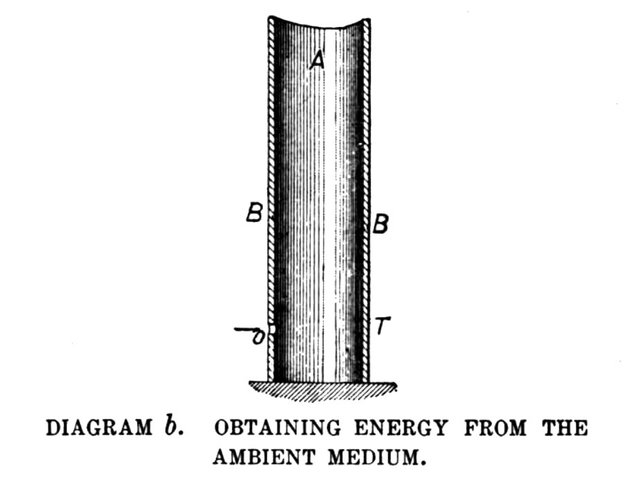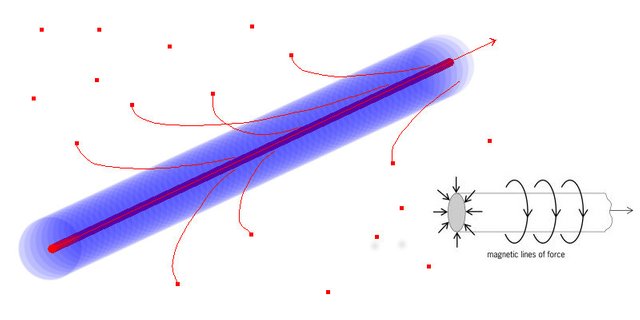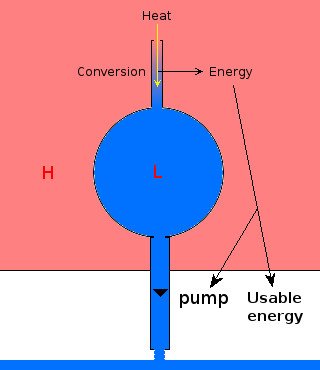Reading Nikola Tesla – part 11: A departure from known methods
Here we are in 2018, over a hundred years later speculating about what could have been Nikola Tesla’s secret. I then think to myself: if only I could show you what I read, you would understand that there is no secret. When I read his articles and patents from 1900 onward, what I see is a man desperately trying to get his views across. He tries again and again in many different ways, but no-one seems to see what I see.

(Some internet fools say that Tesla is reading Boskovich here. As anyone can read in the article of May 20th, 1896 “Tesla’s Important advances”, he was reading one of the "Scientific Papers" of Maxwell)
It is my sincere wish that one day people will read Tesla’s articles and really understand what he is saying.
So… Let me take you by the hand an walk you through his most famous article: “The Problem of Increasing Human Energy”, published in Century Illustrated Magazine of June 1900.
In this part Tesla introduces the basic concept of his “self acting engine”, the details of which will be worked out in the next chapter. As there is a lot of information given here, in the next chapter and in the chapter about the manufacture of iron, I will add a summary at the end of this entire article in which I will combine all the parts.
Previous parts can be found here:
Part 1: Laying a foundation
Part 2: What is electricity?
Part 3: Burning Nitrogen...
Part 4: How to overcome natural resistance
Part 5: Telautomatics
Part 6: Introduction to Harnessing the Sun’s Energy
Part 7: The Manufacture of Iron? Or ...
Part 8: The coming age of aluminium
Part 9: The cold-coal battery
Part 10: Energy from the medium
We continue in the main article where we’d left off.
A DEPARTURE FROM KNOWN METHODS
—POSSIBILITY OF A "SELF-ACTING" ENGINE OR MACHINE, INANIMATE, YET CAPABLE, LIKE A LIVING BEING, OF DERIVING ENERGY FROM THE MEDIUM—THE IDEAL WAY OF OBTAINING MOTIVE POWER.
When I began the investigation of the subject under consideration, and when the preceding or similar ideas presented themselves to me for the first time, though I was then unacquainted with a number of the facts mentioned, a survey of the various ways of utilizing the energy of the medium convinced me, nevertheless, that to arrive at a thoroughly satisfactory practical solution a radical departure from the methods then known had to be made. The windmill, the solar engine, the engine driven by terrestrial heat, had their limitations in the amount of power obtainable. Some new way had to be discovered which would enable us to get more energy. There was enough heat-energy in the medium, but only a small part of it was available for the operation of an engine in the ways then known. Besides, the energy was obtainable only at a very slow rate. Clearly, then, the problem was to discover some new method which would make it possible both to utilize more of the heat-energy of the medium and also to draw it away from the same at a more rapid rate.
Here we have come to the core of the article: the “self-acting machine” that would derive power from the medium. This is Tesla’s solution for getting energy without burning fuels.
I was vainly endeavouring to form an idea of how this might be accomplished, when I read some statements from Carnot and Lord Kelvin (then Sir William Thomson) which meant virtually that it is impossible for an inanimate mechanism or self-acting machine to cool a portion of the medium below the temperature of the surrounding, and operate by the heat abstracted. These statements interested me intensely. Evidently a living being could do this very thing, and since the experiences of my early life which I have related had convinced me that a living being is only an automaton, or, otherwise stated, a "self-acting-engine," I came to the conclusion that it was possible to construct a machine which would do the same. As the first step toward this realization I conceived the following mechanism. Imagine a thermopile consisting of a number of bars of metal extending from the earth to the outer space beyond the atmosphere. The heat from below, conducted upward along these metal bars, would cool the earth or the sea or the air, according to the location of the lower parts of the bars, and the result, as is well known, would be an electric current circulating in these bars. The two terminals of the thermopile could now be joined through an electric motor, and, theoretically, this motor would run on and on, until the media below would be cooled down to the temperature of the outer space. This would be an inanimate engine which, to all evidence, would be cooling a portion of the medium below the temperature of the surrounding, and operating by the heat abstracted.
Step 1: the thermopile. The first picture Tesla presents us is a machine that operates on the temperature difference between the Earth and outer space. Now remember that electricity in Tesla's view is caused by a gaseous medium. And a gas acts more or less conform the ideal gas law: P·V = N·kB·T. Pressure of a gas (P) relates to voltage, volume (V) to capacitance, quantity (N) to charge. And now Tesla is talking about what everybody seems to overlook: the temperature of electricity. Tesla has introduced this concept much earlier in this article and referred to it part 6 where he mentioned that he would have to delve into the meaning of the “hypothetical velocity” in order to fully explain his line of reasoning. Yet to be honest, he already did do so in part 2 with his example of the canon-ball at rest.

A, medium with little energy; B, B, ambient medium with much energy; O, path of the energy.
But was it not possible to realize a similar condition without necessarily going to a height? Conceive, for the sake of illustration, a cylindrical enclosure T, as illustrated in diagram b, such that energy could not be transferred across it except through a channel or path O, and that, by some means or other, in this enclosure a medium were maintained which would have little energy, and that on the outer side of the same there would be the ordinary ambient medium with much energy. Under these assumptions the energy would flow through the path O, as indicated by the arrow, and might then be converted on its passage into some other form of energy. The question was, Could such a condition be attained? Could we produce artificially such a "sink" for the energy of the ambient medium to flow in? Suppose that an extremely low temperature could be maintained by some process in a given space; the surrounding medium would then be compelled to give off heat, which could be converted into mechanical or other form of energy, and utilized. By realizing such a plan, we should be enabled to get at any point of the globe a continuous supply of energy, day and night. More than this, reasoning in the abstract, it would seem possible to cause a quick circulation of the medium, and thus draw the energy at a very rapid rate.
This is an interesting thought experiment. It looks like we are fooling Mother Nature, and the question then is: “Can Mother Nature be fooled?” Remember Tesla is talking about electric temperature.

A current creates a magnetic field which constricts the current. This is called the pinch effect.
With a very strong electric field we can create a movement in free charges, which is in fact a current, and because of the pinch effect, the current constricts itself creating a second suction effect.
So the current removes charges from its direct environment (it removes energy from our “cylinder”), which are replenished by the environment slightly further away (the medium outside our cylinder). But once they try to fill the void they get sucked into the current (converted into a different form and taken out). You can also look at it in this way: Temperature is a chaotic movement, the magnetic field caused by the current directs this chaotic movement in one direction and therefore the pressure (voltage) to the outside drops. This lack of outside pressure in the discharge makes that the surrounding charges, which still do have pressure, force themselves into the discharge, get converted into a current and enforce the magnetic field that is needed for this process.
Here, then, was an idea which, if realizable, afforded a happy solution of the problem of getting energy from the medium. But was it realizable? I convinced myself that it was so in a number of ways, of which one is the following. As regards heat, we are at a high level, which may be represented by the surface of a mountain lake considerably above the sea, the level of which may mark the absolute zero of temperature existing in the interstellar space. Heat, like water, flows from high to low level, and, consequently, just as we can let the water of the lake run down to the sea, so we are able to let heat from the earth's surface travel up into the cold region above. Heat, like water, can perform work in flowing down, and if we had any doubt as to whether we could derive energy from the medium by means of a thermopile, as before described, it would be dispelled by this analogue. But can we produce cold in a given portion of the space and cause the heat to flow in continually? To create such a "sink," or "cold hole," as we might say, in the medium, would be equivalent to producing in the lake a space either empty or filled with something much lighter than water. This we could do by placing in the lake a tank, and pumping all the water out of the latter. We know, then, that the water, if allowed to flow back into the tank, would, theoretically, be able to perform exactly the same amount of work which was used in pumping it out, but not a bit more. Consequently nothing could be gained in this double operation of first raising the water and then letting it fall down. This would mean that it is impossible to create such a sink in the medium. But let us reflect a moment. Heat, though following certain general laws of mechanics, like a fluid, is not such; it is energy which may be converted into other forms of energy as it passes from a high to a low level. To make our mechanical analogy complete and true, we must, therefore, assume that the water, in its passage into the tank, is converted into something else, which may be taken out of it without using any, or by using very little, power. For example, if heat be represented in this analogue by the water of the lake, the oxygen and hydrogen composing the water may illustrate other forms of energy into which the heat is transformed in passing from hot to cold. If the process of heat transformation were absolutely perfect, no heat at all would arrive at the low level, since all of it would be converted into other forms of energy. Corresponding to this ideal case, all the water flowing into the tank would be decomposed into oxygen and hydrogen before reaching the bottom, and the result would be that water would continually flow in, and yet the tank would remain entirely empty, the gases formed escaping. We would thus produce, by expending initially a certain amount of work to create a sink for the heat or, respectively, the water to flow in, a condition enabling us to get any amount of energy without further effort. This would be an ideal way of obtaining motive power. We do not know of any such absolutely perfect process of heat-conversion, and consequently some heat will generally reach the low level, which means to say, in our mechanical analogue, that some water will arrive at the bottom of the tank, and a gradual and slow filling of the latter will take place, necessitating continuous pumping out. But evidently there will be less to pump out than flows in, or, in other words, less energy will be needed to maintain the initial condition than is developed by the fall, and this is to say that some energy will be gained from the medium. What is not converted in flowing down can just be raised up with its own energy, and what is converted is clear gain. Thus the virtue of the principle I have discovered resides wholly in the conversion of the energy on the downward flow.

This is exactly the same as the previous paragraph with a few additions. Again Tesla mentions “we are able to let heat (electric temperature) from the earth's surface travel up into the cold region above”. Remember the first diagram on the production of iron where water is split into hydrogen and oxygen. Tesla uses the same analogy here, linking these two parts, however, in this scheme the energy that is attracted is split into two components, while in the first diagram the energy that we start out with is split to be recombined with a component found in air.
So what is Tesla talking about?
The PCR’s heat the Earth, causing an electric potential. Remember that according to P·V = N·kB·T, we can raise the electric potential (pressure, P) by increasing the charge (N), reducing the capacitance (volume, V) or… raising the temperature (T). This terrestrial heat flows through our atmosphere and we interpret this as an electric current (about 1800A worldwide) although no translatory movement of charges is involved. If it were then the Earth potential would rise roughly a million volts every 4 seconds, which is evidently not the case. Modern science says that lightning returns this charge back to Earth, but that doesn’t make any sense as lightning only acts in the lower few Km’s of our atmosphere. Also if the modern explanation were true then one of these currents goes against the electrical gradient.
So, to capture this flow of energy we need to create a low electric temperature near the Earth’s surface, draw in this heat and convert it into a usable form.
How do we do that? Tesla will explain this in the next part.
So stay tuned!